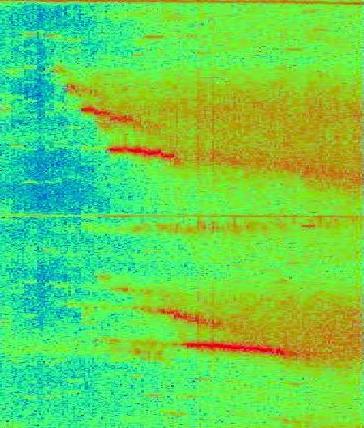Dynamo 3
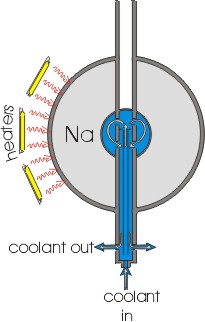
Of the four dynamo experiments, Dynamo III most closely models a flow one might find in Earth's outer core. The apparatus marks our return to rotating convection experiments. It is 60 cm in diameter and may rotate up to 100 rev/sec (this puts us in a somewhat frightening, but unexplored region of parameter space: Ra = 1011, E = 10-8). The sodium is contained between two corotating concentric spheres. The outside of the sphere is heated with quartz-tungsten IR bulbs, and hexane is pumped up through the central shaft to cool the inner sphere. The temperature difference, along with the rotation, drives convection in the sodium.
We will measure heat flux through both the inner and outer sphere. Temperature and Magnetic field will also be measured in the rotating frame. All the data taken on the rotating frame will be transmitted to the lab frame via a microprocessor controlled IR link (like a remote control).
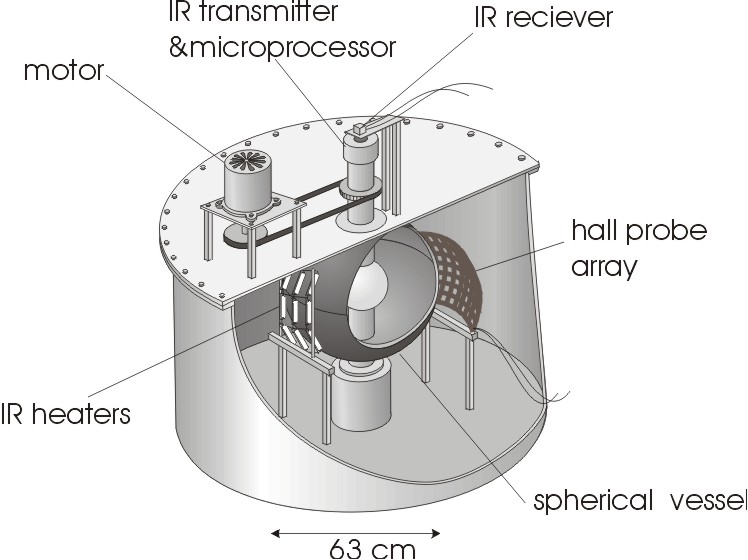
The following photos were taken recently (12-18-02) while collecting convection data with water instead of sodium. With water we are able to reach Ra = 1014. The photo on the left was taken through a window in the outer containment vessel. The photo on the right is a rear view of the heater array.
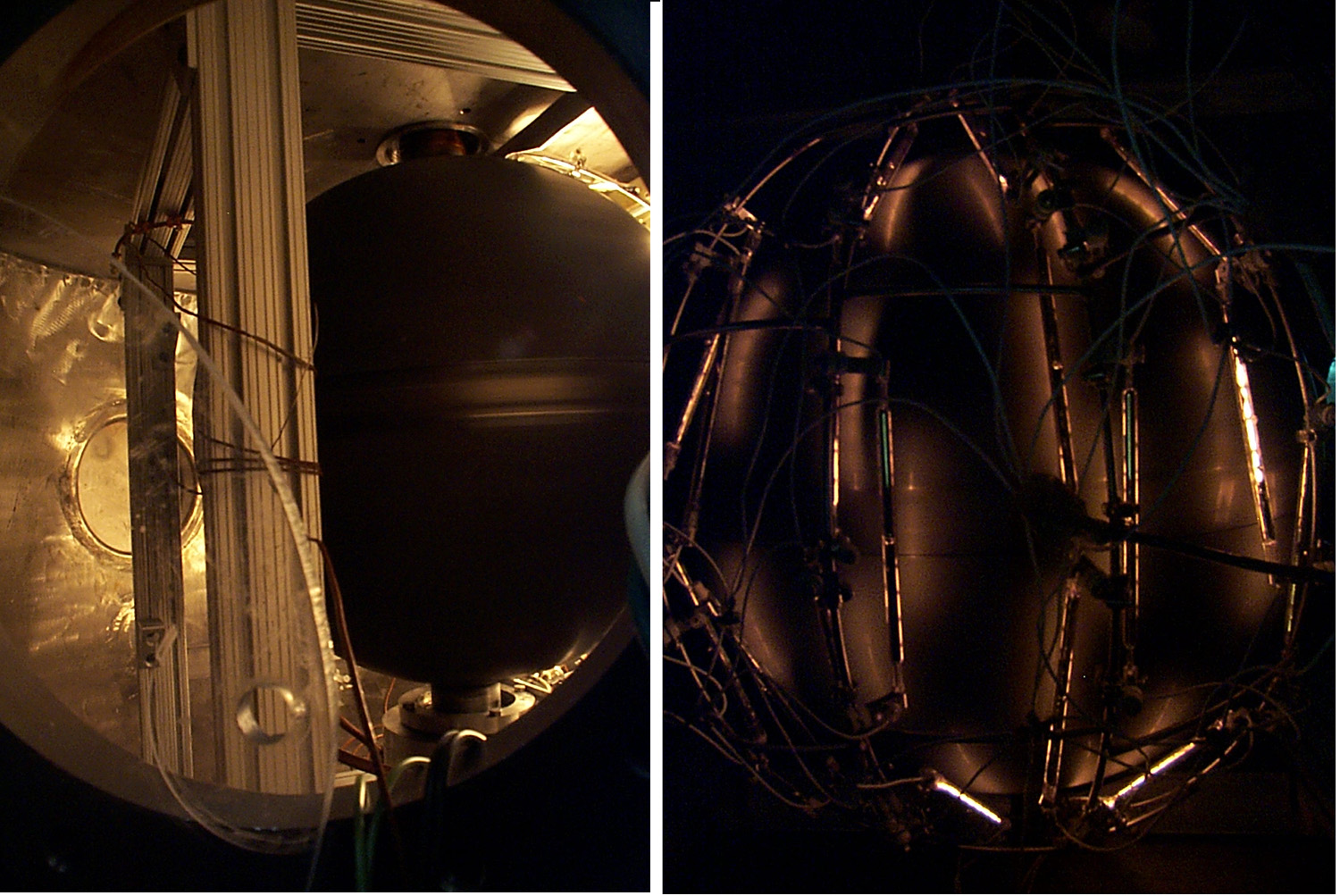
As in Dynamo II, we will diagnose how close we are to self-generation by applying external magnetic pulses (100 G) to the sodium and measuring the rate at which the pulse decays. The slower the decay, the closer we are to a dynamo. We will study the system in the presence of large fields as has been done with Dynamo II.
Dynamo 3.5
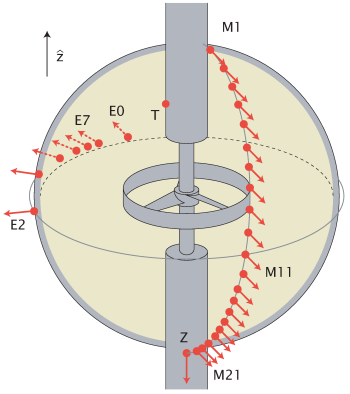
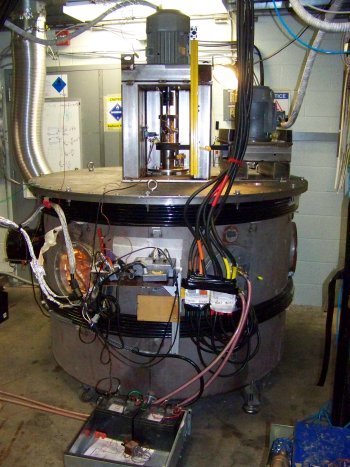
Dynamo 3.5 is a modified version of Dynamo III. Its outer spherical vessel is 60 cm in diameter, can hold about 110 liters of sodium, and rotates, driven by an AC motor. Dynamo 3.5 differs from Dynamo III in that the fluid motions are initiated mechanically (instead of thermally) via an inner shaft that also rotates, independent of the outer vessel, driven by a separate AC motor. By forcing the fluid mechanically, we gain access to faster, more turbulent flows and new dynamics. Our data is comprised of magnetic field measurements, taken with a collection of Hall probes mounted near the surface of the sphere (red dots with arrows in the diagram). We've subjected the flow to various external magnetic fields; our current setup uses a pair of electromagnets oriented parallel to the axis of rotation that can produce about 400 G, as well as a second, smaller pair oriented transverse to the axis.
Spherical Coutte flow and inertial waves
For the first set of experiments in Dynamo 3.5, we constructed an inner sphere (20 cm in diameter) and mounted it on the inner shaft, concentric with the outer sphere, in the so-called spherical Couette geometry. The 1:3 radius ratio models the Earth's core. Applying a DC magnetic field, we see significant AC magnetic induction at some rotation rate combinations, and have been able to identify many of the induction patterns as inertial modes. Our results (Kelley et al 2007) are forthcoming in Geophysical and Astrophysical Fluid Dynamics.
S1T1 flow
More recently we have replaced the inner sphere with a propeller that pumps fluid upward along the axis of rotation. By adjusting the speed of the propeller and the speed of the outer sphere, we can tune the ratio of pumping to rotation, which allows us to seek the S1T1 dynamo mode predicted numerically by Dudley and James in 1989. Six baffles, each 2 cm thick and mounted on the inner surface of the sphere, reduce rotation of the fluid. Initial results from this configuration show wave-like behavior consistent with the dispersion relation that governs full-sphere Rossby waves. Currently under construction is an additional probe array (up to E7, as shown in diagram) allowing the unique identification of wave patterns with much finer structure (up to m=46) to verify the presence of Rossby waves.
Data
Some data that was collected can be found at Data.
The 60cm rotating convection experiment known formerly as Dynamo III has been precision refitted with a 20cm solid copper inner sphere. The outer and inner spheres can rotate independently, up to 35Hz outer and +/- 45Hz (co/counterrotating) inner sphere. Magnetic fields up to .015-.02T have be applied to the system.
The sound you hear is a time series of one hall probe measuring the induced magnetic field over an entire experimental run. The probe was sampled at 2048Hz and played back at 44.1kHz, speeding everything up by over 20x.
In the mp3 files, the outer sphere was held at a constant rotation rate (30 Hz), and the inner sphere swept through a range of rotation rates with a constant applied magnetic field. There are a number of modes with their own distinct frequency peaks, which you can hear in the sound.
Upcoming plans for Dynamo 3.5
- More carefully characterize the onset of inertial waves in spherical Couette flow, which seems to be associated with over-reflection at a shear layer.
- Reproduce the magnetorotational instability in spherical Couette flow, as observed in a similar experiment by Sisan et al.
- Use twin, back-to-back propellers to seek the S2T1 dynamo predicted by Dudley and James.
- Install a roughened inner spere.
- Implement direct velocity measurement of the flow.
Theses
- Anthony Mautino, Inverse spectral methods in acoustic normal mode velocimetry of high Reynolds number spherical couette flows, MS Thesis, UMD 2016
- Matthew Adams, Magnetic and acoustic investigations of turbulent spherical flow, UMD 2016
- Douglas H. Kelley, Rotating, Hydromagnetic laboratory experiment modelling planetary cores,UMD 2009
- Woodrow Shew, Liquid sodium model of earth's outer core, UMD 2004
Publications
- H. Matsui, M. Adams, D. Kelley, S.A. Triana, D. Zimmerman, B.A. Buffett and D.P. Lathrop. Numerical and experimental investigation of shear-driven inertial oscillations in an Earth-like geometry. Physics of the Earth and Planetary Interiors. 188 (3-4): 194-202 (2011). [DOI] [ADS]
- D.H. Kelley, S.A. Triana, D.S. Zimmerman and D.P. Lathrop. Selection of inertial modes in spherical Couette flow. Physical Review E. 81 (2) (2010). [PDF] [DOI] [ADS]
- S.A. Triana, D.H. Kelley, D. Zimmerman, D. Sisan and D.P. Lathrop. Hopf bifurcations with fluctuating gain. Astronomische Nachrichten. 329 (7): 701-705 (2008). [PDF] [DOI] [ADS]
- D.H. Kelley, S.A. Triana, D.S. Zimmerman, A. Tilgner and D.P. Lathrop. Inertial waves driven by differential rotation in a planetary geometry. Geophysical & Astrophysical Fluid Dynamics. 101 (5-6): 469-487 (2007). [PDF] [DOI]
- D.H. Kelley, S.A. Triana, D.S. Zimmerman, B. Brawn, D.P. Lathrop and D.H. Martin. Driven inertial waves in spherical Couette flow. Chaos. 16 (4): 041105 (2006). [DOI] [ADS]
- W.L. Shew and D.P. Lathrop. Liquid sodium model of geophysical core convection. Physics of the Earth and Planetary Interiors. 153 (1-3): 136-149 (2005). [DOI] [ADS]

